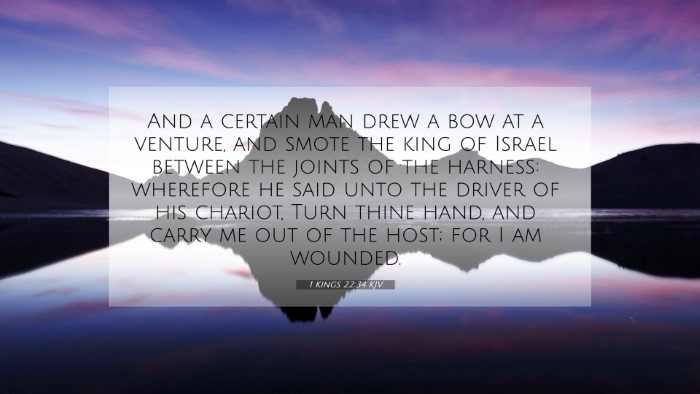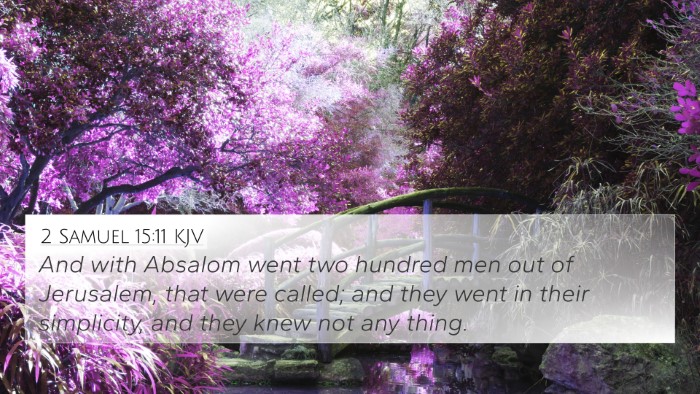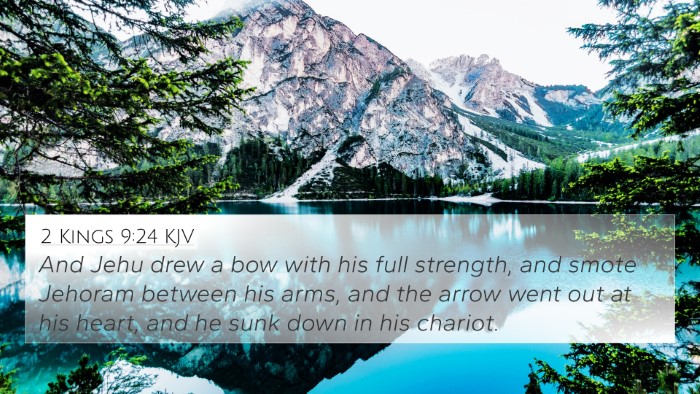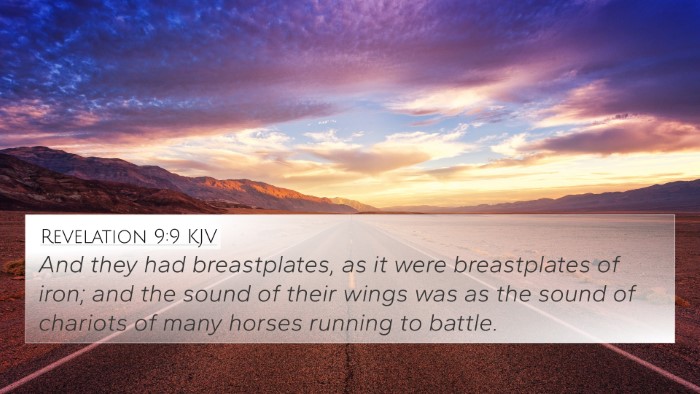Understanding 1 Kings 22:34
1 Kings 22:34 states: "But a certain man drew a bow at a venture, and smote the king of Israel between the joints of the harness: therefore he said unto the driver of his chariot, Turn thine hand, and carry me out of the host; for I am wounded."
This verse captures a pivotal moment in the narrative of King Ahab's death during the battle against the Syrians. The text provides profound insights when analyzed through the lenses of multiple public domain commentaries.
Commentary Insights
Matthew Henry's Commentary
Henry highlights the element of divine providence in this seemingly random event where a soldier, without aiming at Ahab directly, strikes him. This reflects the belief that God orchestrates outcomes even in what appears as chance occurrences. Henry suggests this incident serves as a metaphor for God's judgment and the inevitable consequences of Ahab's previous sinful actions, pointing to God's sovereignty over all happenings.
Albert Barnes' Notes
Barnes emphasizes the implication of divine justice in the context of Ahab's life. He argues that despite Ahab's attempts to deceive and manipulate events to preserve his life, he could not escape the consequences of his decisions. Barnes notes that the random nature of the arrow that found its mark serves as a reminder that those who set out to destroy others can often become victims of their own schemes. His fate is presented as the result of his rebellion against God's will.
Adam Clarke's Commentary
Clarke focuses on the arrow and the man's unintentional targetting, suggesting that it symbolizes the unseen hand of God at work. Clarke’s interpretation stresses that while Ahab believed he was untouchable in his cunning and strategy, the truth was that he was an instrument of his own destruction. This further serves to illustrate the theme of how God's plans can unfold in ways humans do not anticipate, underlining the importance of moral integrity in leadership.
Bible Cross References
- 1 Kings 20:42: This verse presents the prophecy of Ahab's demise as a direct consequence of his actions, reinforcing the theme of divine retribution.
- 2 Chronicles 18:33: Similar context where Micaiah the prophet foretells Ahab's doom, linking the narrative threads of fate.
- Proverbs 16:33: "The lot is cast into the lap, but the whole disposing thereof is of the Lord," resonates with the randomness of Ahab's death.
- Galatians 6:7: The principle of reaping what one sows aligns with the consequences Ahab faces for his misdeeds.
- 2 Thessalonians 1:6: God repaying tribulation to those who trouble His people ties into the theme of justice throughout scripture.
- Revelation 16:6: Those who shed blood being given blood to drink parallels Ahab’s fate relating to his reign of injustice.
- Isaiah 10:1-2: A warning against unjust decrees draws a connection to Ahab's leadership mistakes, linking prophetic messages about justice.
Thematic Connections
Analyzing 1 Kings 22:34 reveals significant themes prevalent throughout the Bible, such as divine justice, the unpredictability of life, and the consequences of sin. This allows for an examination of the broader narrative concerning the divine judgment seen in various instances within both the Old and New Testaments.
Connections Between Bible Verses
The insights gathered indicate a profound inter-Biblical dialogue about leadership, morality, and divine sovereignty. By identifying cross-referencing Biblical texts, readers gain deeper understanding. Tools for Bible cross-referencing can aid in uncovering these connections more intricately.
Interpreting the Verse through Cross-Referencing
The verse serves as part of a larger theme within Scripture emphasizing that God’s will ultimately prevails over human plans. In our faith journey, recognizing Bible verses that relate to each other enriches comprehension and brings clarity to complex narratives.
Conclusion
In conclusion, 1 Kings 22:34 is not just a historical account but serves as a rich source of understanding regarding divine justice and the consequences of human choices. Utilizing a Bible cross-reference guide can illuminate connections across the scriptures, enhancing both personal study and communal insights.









